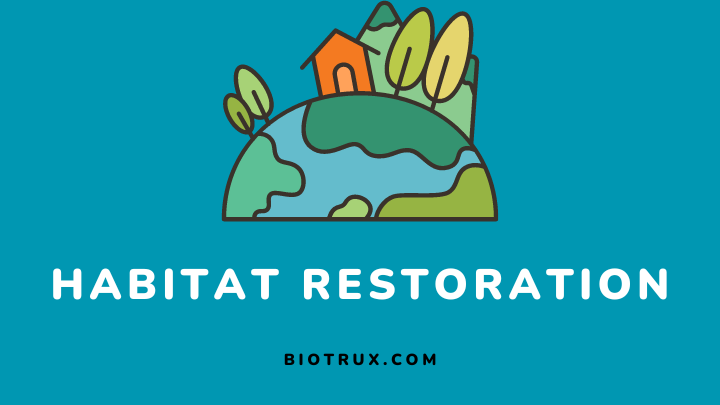Our planet is remarkable, but it’s no secret that we have taken a toll on many ecosystems. From polluting our oceans to deforestation and urbanization, we have caused habitat destruction to many of our precious habitats. However, all is not lost, as habitat restoration is becoming an increasingly crucial aspect of conservation efforts worldwide.
Restoring habitat benefits our environment and improves our quality of life. It helps to sustain biodiversity, combat climate change, and promote ecological stability.
In this article, you will delve into the importance of habitat restoration, its benefits, the methods and steps involved, and the critical role communities play in this process. So, let’s dive in and explore how we can work together to restore the habitats we have damaged intentionally and inadvertently.
What is Habitat Restoration?
Habitat restoration refers to the intentional process of rehabilitating an ecosystem damaged, degraded, or destroyed due to human activities or natural disturbances.
This practice aims to recreate a functioning ecosystem by reinstating essential components, such as native species, soil chemistry, and water quality.
Successful restoration requires a deep understanding of species’ life cycles, interactions, and the resources necessary to sustain their populations. Overall, habitat restoration contributes to a healthier environment and promotes the resilience of natural ecosystems.
Why is Habitat Restoration Important?
Habitat restoration is important because it repairs humans’ damage to the natural environment. Many ecosystems worldwide have been destroyed or altered due to human activity, such as deforestation, pollution, and the effects of climate change.
This has led to biodiversity loss, as many plants and animals cannot survive in these altered environments. Restoring habitats can help reverse this damage by creating a more natural and sustainable environment.
This can help support a wider range of plant and animal species and benefit humans. These benefits include cleaner air and water and more opportunities for recreation and enjoyment of the natural world.
Benefits of Habitat Restoration
Restoring habitats has many benefits both for the environment and human society. Some of the key benefits include:
1. Biodiversity conservation
Restoring habitats can increase ecosystems’ biodiversity, leading to a healthier and more resilient natural environment. This can also help protect endangered or threatened species, which may be at risk of extinction due to habitat loss or fragmentation.
2. Climate change mitigation
Healthy ecosystems are imperative in the fight against climate change, as they absorb and store carbon dioxide from the atmosphere. This can help reduce the amount of greenhouse gases in the atmosphere, which are a major contributor to global warming.
3. Improved water quality
Healthy ecosystems can improve water quality by filtering pollutants and reducing erosion. This can lead to cleaner waterways and healthier aquatic habitats.
4. Recreational opportunities
Restored habitats can provide outdoor recreation, such as hiking, birdwatching, and fishing. This can provide individuals with various physical and mental health benefits and boost the local economy through tourism.
Methods of Habitat Restoration
1. Passive restoration
Passive restoration involves no human intervention in recovering an ecosystem. It mainly relies on natural processes such as wind, water, and wildlife to restore the environment to its natural state.
Some examples of passive restoration include using grazing animals to manage vegetation naturally and allowing areas to revegetate naturally.
Pros of passive restoration
- Cost-effective restoration method, as it requires less manpower and equipment compared to active restoration methods.
- Generally less invasive, as it does not require heavy machinery or the introduction of new species.
- Low maintenance requirements, as the ecosystem is left to develop independently.
Cons of passive restoration
- Since passive restoration mainly relies on natural processes, it can take years, if not decades, to see significant improvement.
- Passive restoration has limited control over restoration outcomes, and the results may be unpredictable.
- Passive restoration is vulnerable to external factors such as drought, fire, and climate change, which can hinder or delay the restoration process.
In summary, passive restoration can be an effective and sustainable method of restoring habitats if given enough time and the right environmental circumstances.
2. Active restoration
Active restoration involves the direct human manipulation of the environment to restore degraded habitat.
Examples of active restoration projects include planting native vegetation, removing invasive species, reintroducing native species, or limiting human activities like agriculture or mining that contribute to environmental stressors.
Pros of active restoration
- Faster and more predictable results
- Greater control over the restoration process
- Ability to target specific areas or species
Cons of active restoration
- Higher costs
- Potential unintended consequences
- Need for ongoing maintenance and management
Overall, active restoration can be an effective tool to restore habitats when considering the desired outcome, budget, and potential impacts on the ecosystem.
By weighing the pros and cons, conservation efforts can decide on the best approach to restore and protect our natural habitats.
3. Mixed restoration
Mixed restoration is a habitat restoration method that combines different restoration techniques to achieve a more diverse and resilient ecosystem. Integrating various approaches, mixed restoration addresses different aspects of habitat degradation and promotes ecological balance.
Examples of mixed restoration include combining native plantings with prescribed burns or using livestock grazing to manage invasive species. These innovative strategies help create a more stable and flourishing habitat for various plant and animal species.
Pros of mixed restoration
- Mixed restoration promotes a richer and more diverse habitat for various species to thrive using various restoration techniques.
- Mixed restoration enhances overall ecosystem functions, such as nutrient cycling and water filtration, by addressing different aspects of habitat degradation.
- Greater resilience to disturbances: A diverse and well-functioning ecosystem is more likely to withstand and recover from environmental disturbances such as climate change, pests, and diseases.
Cons of mixed restoration
- Implementing multiple restoration techniques may require more resources, time, and funding than a single restoration method.
- Managing a mixed restoration project can be challenging, as it involves coordinating different strategies and monitoring their effects on the ecosystem.
In conclusion, by carefully considering these pros and cons, restoration practitioners can select the ideal strategies to meet their restoration objectives and create more sustainable and resilient ecosystems.
Steps Involved in Habitat Restoration
Habitat restoration involves several key steps depending on the ecosystem being restored and the method implemented. Some of the key steps include:
1. Assessment
The first step in habitat restoration is to assess the ecosystem’s current condition and determine the damage’s extent. This may involve surveying plant and animal populations, measuring water quality, and identifying sources of pollution or other environmental stressors.
2. Planning
Based on the assessment, a restoration plan is developed that outlines the specific actions that will be taken to restore the habitat. This may involve planting native vegetation, removing invasive species, or restoring wetlands or other aquatic habitats.
3. Implementation
The restoration plan is put into action, typically through volunteer and professional efforts. This may involve planting trees or other vegetation, constructing habitat features such as nesting boxes or birdhouses, or removing debris or other environmental pollutants.
4. Monitoring
After the restoration work is complete, ongoing monitoring is typically needed to track the success of the restoration effort and identify any additional work that may be needed to maintain the ecosystem’s health.
Role of Communities in Habitat Restoration

Communities play a crucial role in habitat restoration by providing a collective effort toward preserving and restoring local ecosystems. Across the world, communities are involved in restoration initiatives such as cleaning up waterways, planting trees, and restoring degraded habitats.
There are many ways in which communities can get involved in habitat restoration, such as volunteering, fundraising, and advocating for policies that support restoration efforts.
Communities can also take on specific roles in restoration projects. For example, they can be responsible for monitoring water quality, maintaining trails, and removing invasive species. They can also provide crucial support by sharing knowledge, skills, and resources.
Engaging communities in habitat restoration leads to numerous benefits, including:
- Increased awareness and appreciation of local ecosystems and biodiversity.
- Improved community well-being and sense of place.
- Enhanced ecological resilience and ecosystem function.
- Increased social and environmental stewardship.
In conclusion, habitat restoration is the responsibility of scientists, government agencies, and the general public. Communities can play a significant role in restoration efforts by getting involved in various ways, from volunteering to fundraising.
FAQs
What are some common habitat restoration techniques?
Common habitat restoration techniques include planting native vegetation, removing invasive species, restoring wetlands or other aquatic habitats, and creating or enhancing habitat features such as nesting boxes or birdhouses.
What are some challenges to habitat restoration efforts?
Habitat restoration can be challenging and complex, often involving restoring ecosystems altered or destroyed by human activity.
Some challenges include limited resources, lack of public awareness or support, and difficulty predicting restoration efforts’ long-term success.
How long does habitat restoration take?
The length of time needed for habitat restoration depends on the extent of the damage and the specific restoration techniques being used. Some restoration efforts may take only a few months, while others may take several years or even decades to restore an ecosystem fully.
How can you get involved in habitat restoration efforts?
There are many ways to get involved in habitat restoration efforts. These include volunteering with local organizations, donating to conservation groups, or advocating for policies that support habitat restoration and conservation.
Are there any success stories of habitat restoration efforts?
There are many success stories of habitat restoration efforts, from the restoration of wetlands and streams to the recovery of endangered species populations.
Some examples include the restoration of the Chesapeake Bay in the United States, the recovery of the California Condor population, and the restoration of degraded grasslands in Europe.
Final Thoughts
In conclusion, habitat restoration is essential in our fight to preserve the environment and protect biodiversity. It requires a collaborative effort between individuals, organizations, and communities working towards a common goal.
The benefits of habitat restoration extend beyond just environmental benefits. It provides economic benefits, such as creating green jobs and tourism. It also improves our quality of life by providing a healthier environment for us to live in.
The steps in habitat restoration may seem daunting, but starting small makes a big difference. Even a tree planted or a patch of grass restored can provide a habitat for many species.
Communities play a vital role in habitat restoration. We can significantly impact our environment by educating each other, spreading awareness, and volunteering.
Let’s work together to restore habitats and protect the environment. Remember, the planet is not just for us but for future generations too. Let’s leave it better than we found it.
You can also find out if going green is worth it.
Thanks for reading.
